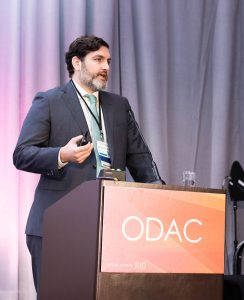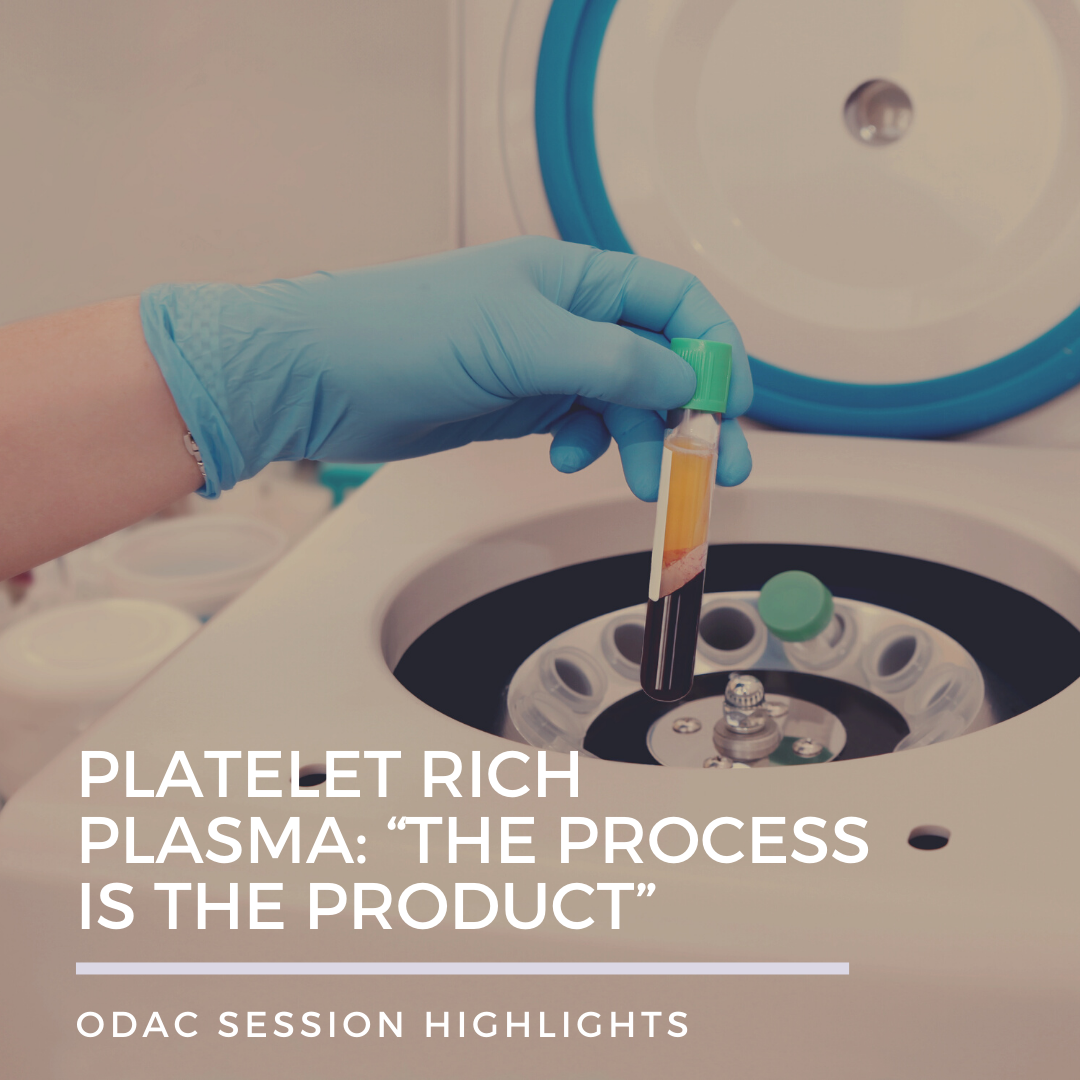Platelet-rich plasma or PRP, derived from the patient’s own blood, is considered by many to be an all-natural, safe product with rejuvenation properties. Here, we discuss what exactly is PRP, the qualities that would make an ideal PRP extraction system, and the work that lies ahead to standardize current treatment protocols.
 Dr. Terrence Keaney led a lecture on platelet-rich plasma (PRP) at the 17th Annual ODAC Dermatology, Aesthetic and Surgical Conference which took place January 17-20 in Orlando, FL. PRP has been largely popularized in pop culture and social media as the “vampire facial”, which involves PRP application along with microneedling for facial rejuvenation. PRP is gaining popularity amongst different medical specialties, such as cosmetic dermatology, dentistry, ophthalmology, urology, wound healing, cardiothoracic surgery, and orthopedic surgery given its reputation as a natural and safe product.
Dr. Terrence Keaney led a lecture on platelet-rich plasma (PRP) at the 17th Annual ODAC Dermatology, Aesthetic and Surgical Conference which took place January 17-20 in Orlando, FL. PRP has been largely popularized in pop culture and social media as the “vampire facial”, which involves PRP application along with microneedling for facial rejuvenation. PRP is gaining popularity amongst different medical specialties, such as cosmetic dermatology, dentistry, ophthalmology, urology, wound healing, cardiothoracic surgery, and orthopedic surgery given its reputation as a natural and safe product.
So, what is PRP?
PRP is autologous, concentrated human platelets in a small volume of plasma. Depending on the system used to prepare the PRP, it can contain up to 3-9 times the concentration of platelets found in normal circulation. PRP contains over 800 bioactive molecules secreted by platelets, including cell adhesion molecules, cytokines, anti-microbial peptides, and anti-inflammatory molecules¹.  In essence, PRP is a “cocktail containing many different growth factors and elements that may benefit various different diseases”, said Dr. Keaney. But just as a cocktail can vary drastically depending on the bartender, PRP can differ drastically depending on how it is prepared and its source material.
In essence, PRP is a “cocktail containing many different growth factors and elements that may benefit various different diseases”, said Dr. Keaney. But just as a cocktail can vary drastically depending on the bartender, PRP can differ drastically depending on how it is prepared and its source material.
Lack of standardization
In clinical practice, PRP is easy to deliver. One simply draws blood from a patient, centrifuges the blood, with or without a platelet activator, and then delivers PRP through injection or adjuvant application alongside other procedures (i.e. microneedling or laser).
The Food and Drug Administration (FDA) considers PRP a blood product and its regulation falls under the Center for Biologics Evaluation and Research, hence bypassing the traditional regulatory pathways that require animal studies and clinical trials². Many device manufacturers have brought PRP devices to the market by demonstrating that the new device is substantially equivalent to a currently marketed device². Most devices receive FDA clearance for orthopedic uses such as using PRP with bone grafts. This means that most other uses of PRP, such as for “vampire facials” and hair growth are considered off-label.
As a result of the non-stringent regulatory process, there are many PRP systems on the market and many suggested protocols for cosmetic rejuvenation and hair loss based on case series as opposed to rigorous clinical studies. This means that “we still do not know what the best way to make PRP is”, stated Dr. Keaney.
Factors to consider in PRP production
Dr. Keaney recommends the audience to consider the following when thinking of a good PRP protocol: the concentration of platelets delivered, potential additives (white and red blood cells, exogenous products), and whether PRP or Platelet-rich-fibrin (PRF) should be used. So, what is the ideal PRP concentration for aesthetics and hair growth? In vitro wound healing studies suggest it may be 1.5 million platelets/mL (5x fold the normal range of 150,000-400,000)³, but we do not have in vivo studies supporting this. In terms of additives, Dr. Keaney recommends his patients to take Carica Papaya supplementation 500mg daily prior to PRP treatments based on a study showing increased platelet concentration in patients with thrombocytopenia4.
PRF, the newcomer, is achieved with when no anticoagulant is used in the extraction process along with low G force centrifuging. The resulting product contains platelets and a fibrin network, which ideally helps with cell proliferation, migration, and differentiation. Again, more clinical studies are needed to determine its relative efficacy.
So what are the qualities that make an ideal PRP system?
-
- Simple, quick, and reproducible collection
- Safe & autologous, cleared by the FDA
- Customizable platelet concentration
- Low inflammatory qualities (no red blood cells or white blood cells)
- No burning (physiological pH)
- Adjustable volume (large tube or multi-tube system)
In summary
The scientific reasoning and proposed mechanisms behind the use of PRP for hair loss are sound with a favorable safety profile. However, there is a plethora of different PRP preparations and protocols with no standardization of treatment and a paucity of consistent clinical data. Further clinical studies are needed to determine the optimal PRP concentration for different clinical uses and to establish an ideal PRP preparation system. In all, given the good clinical efficacy he has experienced in his clinical practice, Dr. Keaney supports the use of PRP if done properly using appropriate protocols in the right patient.
Relevant Disclosure: Dr. Keaney is a speaker for Eclipse, a PRP preparation manufacturer.
References
-
- Frautschi RS, Hashem AM, Halasa B, Cakmakoglu C, Zins JE. Current evidence for clinical efficacy of platelet rich plasma in aesthetic surgery: a systematic review. Aesthetic surgery journal. 2016;Sjw178:178. doi:10.1093/asj/sjw178
- Jones IA, Togashi RC, Thomas Vangsness C. The economics and regulation of prp in the evolving field of orthopedic biologics. Current reviews in musculoskeletal medicine. 2018;11(4):558-565. doi:10.1007/s12178-018-9514-z
- Giusti I, Rughetti A, D’Ascenzo S, et al. Identification of an optimal concentration of platelet gel for promoting angiogenesis in human endothelial cells. Transfusion. 2009;49(4):771-778. doi:10.1111/j.1537-2995.2008.02033.x
- Sharma N, Mishra KP, Chanda S, et al. Evaluation of anti-dengue activity of carica papayaaqueous leaf extract and its role in platelet augmentation. Archives of virology : official journal of the virology division of the international union of microbiological societies. 2019;164(4):1095-1110. doi:10.1007/s00705-019-04179-z
This information was presented by Dr. Terrence Keaney at the 17thODAC Dermatology, Aesthetic and Surgical Conference held January 17th-20th, 2020 in Orlando, FL. The above highlights from his lecture were written and compiled by Dr. Yumeng Marina Li, PGY-4 dermatology resident at the University of Miami, and one of the 7 residents selected to participate in the Sun Young Dermatology Leader Mentorship Program (a program supported by an educational grant from Sun Pharmaceutical Industries, Inc.).
Did you enjoy this post? Find more on Medical Dermatology here.

